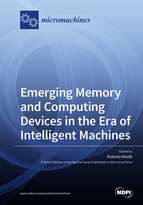Emerging Memory and Computing Devices in the Era of Intelligent Machines
A special issue of Micromachines (ISSN 2072-666X). This special issue belongs to the section "A:Physics".
Deadline for manuscript submissions: closed (30 April 2019) | Viewed by 75658
Special Issue Editor
Interests: magnetic memory; beyond-CMOS computing; magnetic tunnel junctions; microwave magnetic devices; voltage control of magnetism
Special Issue Information
Dear Colleagues,
Computing systems are undergoing a transformation from logic-centric towards memory-centric architectures, where overall performance and energy efficiency at the system level are determined by the density, performance, functionality and efficiency of the memory, rather than the logic sub-system. This is driven by the requirements of data-intensive applications in artificial intelligence, autonomous systems, and edge computing. We are at an exciting time in the semiconductor industry where several innovative device and technology concepts are being developed to respond to these demands, and capture shares of the fast growing market for AI-related hardware. This special issue is devoted to highlighting, discussing and presenting the latest advancements in this area, drawing on the best work on emerging memory devices including magnetic, resistive, phase change, and other types of memory. The special issue is interested in work that presents concepts, ideas, and recent progress ranging from materials, to memory devices, physics of switching mechanisms, circuits, and system applications, as well as progress in modeling and design tools. Contributions that bridge across several of these layers are especially encouraged.
Prof. Pedram Khalili
Guest Editor
Manuscript Submission Information
Manuscripts should be submitted online at www.mdpi.com by registering and logging in to this website. Once you are registered, click here to go to the submission form. Manuscripts can be submitted until the deadline. All submissions that pass pre-check are peer-reviewed. Accepted papers will be published continuously in the journal (as soon as accepted) and will be listed together on the special issue website. Research articles, review articles as well as short communications are invited. For planned papers, a title and short abstract (about 100 words) can be sent to the Editorial Office for announcement on this website.
Submitted manuscripts should not have been published previously, nor be under consideration for publication elsewhere (except conference proceedings papers). All manuscripts are thoroughly refereed through a single-blind peer-review process. A guide for authors and other relevant information for submission of manuscripts is available on the Instructions for Authors page. Micromachines is an international peer-reviewed open access monthly journal published by MDPI.
Please visit the Instructions for Authors page before submitting a manuscript. The Article Processing Charge (APC) for publication in this open access journal is 2600 CHF (Swiss Francs). Submitted papers should be well formatted and use good English. Authors may use MDPI's English editing service prior to publication or during author revisions.
Keywords
- Nonvolatile memory (NVM)
- MRAM
- Spin transfer torque
- Voltage-controlled magnetic switching
- Spin-orbit torques
- Memristors
- RRAM
- Phase-change memory
- Synaptic devices
- Domain walls
- ferroelectrics
- Skyrmions
- Neuromorphic computing
- Computing in memory
- Stochastic and probabilistic computing
- Circuit design for emerging memory concepts
- Applications of emerging NVM devices
- NVM modeling
- CAD tools for emerging memory design







